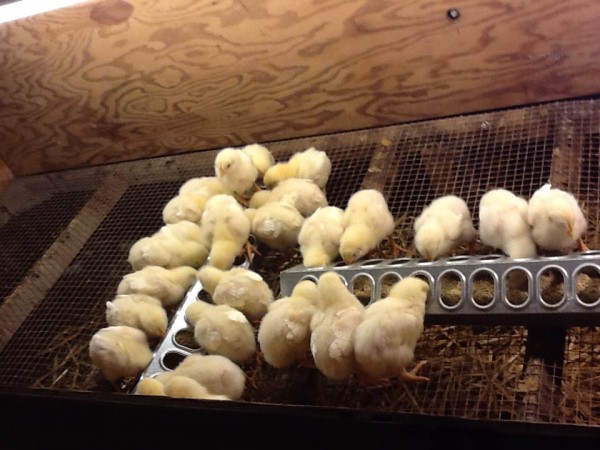Bethel farmer clucking with delight at chicken success
December 17, 2013

907-474-5042
12/1/13
The future of Alaska agriculture is going underground, literally, says Tim Meyers of Bethel.
Meyers, who operates Meyers Farm, is beyond excited about his new discoveries, particularly in the growth of his chicken egg and meat sales. Since building an “underground” barn, he has been able to increase egg and meat production exponentially. The barn was actually constructed above ground, then Meyers pushed sand against it 14 feet high, which keeps the building warm with minimal heat.
Because he is so busy growing produce all summer, Meyers wanted to raise chickens throughout the winter. Beginning mid-December he will start slaughtering chickens every seven weeks. The fresh meat is in such demand at the Bethel Farmers Market that there is a waiting list. He also sells 170 dozen eggs a month. “There is a heck of a demand,” Meyers said. The way customers froth over the eggs is almost embarrassing for Meyers. “It’s kinda scary,” he said. “People are waiting at the market to get them.”
He wishes he’d built a bigger building. “I could sell 300 dozen a month,” he said. The eggs sell for $6.50 a dozen.
For the meat birds, he receives 25 chicks in the mail every other week. Slaughtering 10 to 12 birds a week with a profit of about $20 per bird, Meyers estimates he’ll make $1,600 a month on this side of the business.
He is importing chicken feed, but grows extra cabbage and turnips to feed the older birds. The younger ones need commercial feed.
Cornish Cross is the meat bird of choice for Meyers. “They are a phenomenal, remarkable, productive bird,” Meyers said. “At seven weeks they weigh six to seven pounds.”
For the layers, he alternates between Leghorns (white eggs) and Red Star (brown eggs) each year so he can easily track which birds are losing productivity. Ordinarily, he keeps the layers for two years.
Meyers is so pumped about his chicken success he is planning to offer a 30-day, hands-on course in raising poultry. “The key is building the structure. We could have half a dozen facilities in Kenai and Fairbanks, each making $3,000 a month. A person could make a really good living.
“It’s an easy thing to do,” he said.
Chickens aside, Meyers has singlehandedly changed the food landscape in Bethel, a city of about 6,000 located 400 miles west of Anchorage on the Kuskokwim River. The population has gone from eating pitiful produce that had been barged, trucked and flown in to consuming fresh food grown in their own community. With his underground root cellar, Meyers can store 200,000 pounds of produce, allowing him to sell carrots, potatoes, onions and cabbage long after harvest.
In spite of Bethel’s cool climate, the rich soil makes the difference. Meyers uses fish as fertilizer and follows organic principles. Chicken manure is also a good fertilizer and Meyers will have plenty of it. “We could be the answer to Alaska’s food project,” he said of his beloved community. “We have lots of land and within one year you can grow an organic crop. It’s not that hard and you’d be surprised how much fun it is.”
Meyers sends food boxes to customers in Hooper Bay and St. Mary’s and to nearby school districts. For a brief period, he was even supplying produce to Anchorage’s Natural Pantry, until the demand in Bethel increased to the point he couldn’t send goods to the city anymore.
A truly innovative step has been his import business. A year ago, Meyers decided to undo a food subscription service out of Washington state. He worked with food wholesalers in Seattle and now flies in 1,500 pounds of organic fruits and vegetables every week. Not only did the subscription service drastically reduce, Meyers beat the customer cost by 30 percent. “These prices are similar to Anchorage,” Meyers said.
He sets up shop at the Bethel Farmers Market twice a week and supplements the imported sales with veggies from his root cellar. “It’s fresh; the community is phenomenally happy.”
Ever the pioneer, Meyers is trying a growing technique that will shock some Alaskans, particularly Interior gardeners. He planted seeds, including carrots, beets, broccoli, kale and onions, this fall so the crops will be ready to harvest by July. He uses plastic tunnels to keep the heat in during the summer.
An optimist at heart, Meyers said, “I see huge potential in this.”
Contact info: www.meyersfarm.net
This column is provided as a service by the UAF School of Natural Resources and Agricultural Sciences and the Agricultural and Forestry Experiment Station. Nancy Tarnai is the school and station’s public information officer. She can be reached at ntarnai@alaska.edu.


